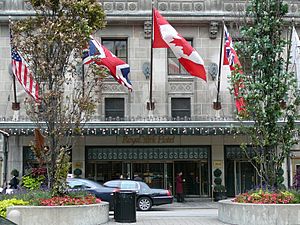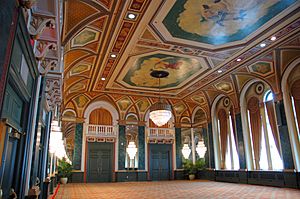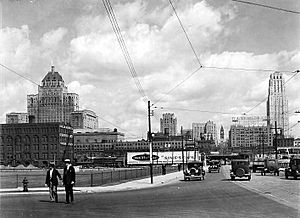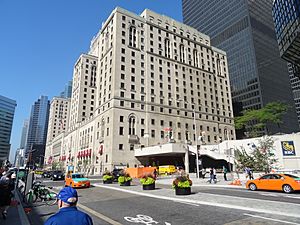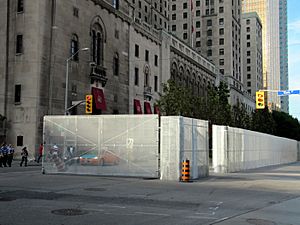Fairmont Royal York facts for kids
The Fairmont Royal York, often called the Royal York, is a huge and historic luxury hotel in Toronto, Ontario, Canada. It's located on Front Street West in the southern part of Toronto's Financial District, right in Downtown Toronto. The hotel was designed by Ross and Macdonald with Sproatt and Rolph, and it was built by the Canadian Pacific Railway. Today, Fairmont Hotels and Resorts manages it.
The hotel opened on June 11, 1929. It's built in a style called Châteauesque, which looks a bit like a French castle. The building is 124 metres (407 feet) tall and has 28 floors. It's known as one of Canada's grand railway hotels. When it was finished, it was briefly the tallest building in Toronto, the tallest in Canada, and even the tallest in the British Empire. But then, the Canadian Bank of Commerce Tower was built the next year and took its record. The Royal York has been updated many times since it opened, with the first big renovation in 1972. There's also an underground walkway that connects the hotel to the Royal Bank Plaza and Union Station. This walkway is part of Toronto's PATH underground city system.
| Fairmont Royal York | |
Quick facts for kids 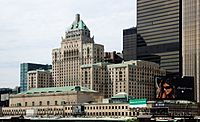 The hotel with Union Station in foreground |
|
| Hotel facts and statistics | |
|---|---|
| Coordinates | 43°38′46″N 79°22′54″W / 43.646133°N 79.381561°W |
| Address | |
| Developer | Canadian Pacific Railway |
| Management | Fairmont Hotels and Resorts |
| Owner | InnVest Hotels LP (20%) KingSett Capital Inc. (60%) Ivanhoé Cambridge (20%) |
| No. of restaurants | 4 |
| No. of rooms | 1,363 |
| No. of floors | 28 |
Contents
Discovering the Hotel's Location
The Royal York Hotel is at 100 Front Street West. It's at the south end of the Financial District, which is a busy business area in Downtown Toronto. The hotel is bordered by Piper Street to the north and York Street to the west. To the east, it's next to Royal Bank Plaza, an office complex.
Union Station, Toronto's main train and bus hub, is just south of the hotel, across Front Street West. The Royal York wasn't the first hotel on this spot. An earlier hotel, called the Ontario Terrace, was built here in 1843. It was later torn down to make way for the Royal York.
Because it's in the Financial District, the hotel is close to Canada's main financial hub. It's also near several other downtown areas. To the southwest is the Entertainment District. The neighbourhoods of St. Lawrence and South Core are to the east and south.
The hotel building is part of the Union Station Heritage Conservation District. This is a special historic area around Union Station. It was created in July 2006 to protect important buildings. This district has many different kinds of buildings, from the 1850s to today.
Hotel Design and Features
Building Style and Look
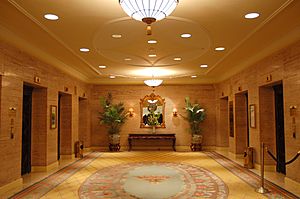
After buying the land, Canadian Pacific Hotels (part of the Canadian Pacific Railway) decided to tear down the old Queen's Hotel. They wanted to build a brand new, grand hotel. The design for the new hotel was created by Canadian architects Ross and Macdonald, working with Sproatt and Rolph. These firms had designed other hotels for Canadian Pacific before.
The building's design changed a few times before they picked the final one. They chose a tall central design to make it stand out. This tall design also meant that most rooms and public areas would have great views of downtown or Lake Ontario. The hotel was finished in 1929. It has a Châteauesque style, with pointed arches on the third floor and a small peaked roof with tiny windows at the top. You can also see cool grotesque statues shaped like griffins on different corners. The outside of the building is made of Indiana Limestone, which covers the hotel's 28-story steel frame.
Besides its castle-like features, the hotel also has some Art Deco elements and Romanesque-inspired decorations. The inside of the hotel was mostly designed in an Edwardian style. It has beautiful crystal chandeliers and a lobby ceiling made of hand-carved wood.
The building is 124 metres (407 feet) tall and has 28 floors. Most of these floors are guest rooms and other hotel spaces. When it was built, it was briefly the tallest building in the British Empire and Canada. It lost this title the next year when the Canadian Bank of Commerce Tower was built nearby.
Work to make the hotel bigger started in 1957 and finished in 1959. This new east wing was designed by Ross, Patterson, Townsend, & Fish, with Charles B. Dolphin.
Hotel Facilities and Amenities
When the Royal York first opened, it had 1,048 guest rooms and suites. It also had a huge telephone switchboard that was over 18 metres (60 feet) long! By 2014, the hotel had expanded to 1,363 guest rooms and suites. You can choose from different types of rooms and eight kinds of suites.
The hotel also has many spaces for events. There's a whole floor of rooms used for conferences and meetings. A famous room is the Ballroom, which has an amazing oil-painted ceiling from when the hotel first opened. The Concert Hall is another event space with a huge Casavant Frères pipe organ. It was once the largest pipe organ in Canada. The Imperial Room was a nightclub from the 1940s to the 1990s. Now, it's used for meetings and events, often by the Empire Club of Canada.
The Royal York also has several restaurants and places to eat. When it first opened, its kitchen was the biggest hotel kitchen in Canada! It could make over 15,000 French bread rolls every day. Some restaurants inside the hotel include Benihana Japanese Steakhouse and the Library Bar, which also serves afternoon tea.
On the fourteenth floor, the hotel has a roof garden where they grow herbs, vegetables, and flowers. This garden provides fresh ingredients for the hotel's restaurants. In 2008, they added three beehives to the roof garden. Now, they have six beehives and a pollinator bee hotel. About 350,000 honey bees live there in the summer, making about 205 kg (450 lbs) of honey each year!
The hotel also has a health club. It has an indoor pool with a skylight, a fitness centre, a whirlpool, and steam rooms.
In 1929, a tunnel was built under Front Street West. This allowed hotel guests to walk directly to Union Station. This tunnel later connected to the larger PATH underground city. The PATH is a network of tunnels that connects many buildings in Downtown Toronto.
A Look at the Hotel's History
The Royal York Hotel wasn't the first hotel on this land. The first one was built in 1843 and was called the Ontario Terrace. After a few changes, it became the Queen's Hotel. In 1925, the Canadian Pacific Railway (CPR) bought the Queen's Hotel. The CPR's president, Sir Edward Wentworth Beatty, announced they would tear it down. They planned to build the largest hotel in the British Commonwealth on that spot. Before it was demolished, the Queen's Hotel was known as "One of the largest and most comfortable hotels in the Dominion of Canada."
Construction on the new hotel began in 1927 and finished in 1929. The new hotel, named the Royal York, cost $16 million to build. It had over 1,000 guest rooms, each with a radio, private shower, and bathtub. It also had a library, a small hospital, and a very tall telephone switchboard.
The hotel officially opened on June 11, 1929. The Viscount Willingdon, who was the Governor General of Canada, opened it in a very fancy event. He was even the first guest to check into the hotel! Many important people from Canada and the USA attended the opening. The event was big news, even on the front page of the Montreal Gazette.
From 1930 to 1935, a radio station called CPRY (for "Canadian Pacific Royal York") broadcast from the hotel's Imperial Room. Its programs were heard all across the country. On September 7, 1949, the hotel's lobby was turned into a temporary hospital. This happened after a fire on the cruise ship SS Noronic in the Toronto harbour.
From the 1940s to the 1990s, the hotel had a famous nightclub called the Imperial Room. Many top musicians and performers played there, like Anne Murray, Louis Armstrong, Ella Fitzgerald, and Tina Turner. Even Jim Carrey performed his first comedy show there! The nightclub is now used for other events.
In 1957, work started to make the hotel bigger with a new east wing. This was finished in 1959.
The hotel had a big renovation in 1972 and 1973 to make it more modern. This project was called the Royal York Revelation. They added a spiral staircase in the lobby and updated many parts of the hotel. From 1988 to 1993, the Royal York went through a huge $100-million restoration.
In 2001, the company that owned the hotel, Canadian Pacific Hotels, changed its name to Fairmont Hotels and Resorts. Because of this, the Royal York was renamed the "Fairmont Royal York." In 2007, the Royal York and other Fairmont hotels were sold to Ivanhoé Cambridge, but Fairmont still manages the hotel.
The official welcome for the leaders of the 2010 G20 Toronto summit was held at the Royal York Hotel on June 26, 2010. Because of this, the hotel was part of the special security zones for the summit.
In 2014, the hotel's ownership changed again. KingSett Capital Inc. and InnVest Real Estate bought 80 percent of the hotel from Ivanhoé Cambridge. After this sale, the new owners announced a C$50-million renovation for the hotel.
Famous People Who Have Stayed Here
Many famous people have stayed at the Royal York. It's often a temporary home for people working in the film industry or in the nearby financial world. The Royal York is also a host hotel for the Toronto International Film Festival, so many celebrities stay there during the festival. Some famous guests include Jennifer Aniston, Justin Bieber, Leonardo DiCaprio, Matt Damon, and Susan Sarandon. The hotel even keeps records of what its guests like to make sure they have a great stay. Hotel employees are not allowed to share any information about the guests.
Many heads of state, diplomats, and other important foreign visitors have also stayed at the Royal York. During the 2010 G20 Toronto summit, the hotel hosted eleven heads of state and heads of government. Leaders like Nicolas Sarkozy, the President of France, and Ronald Reagan, a former President of the United States, have stayed here. Other important guests include American Senator Robert F. Kennedy and the 14th Dalai Lama.
Visits from the Royal Family
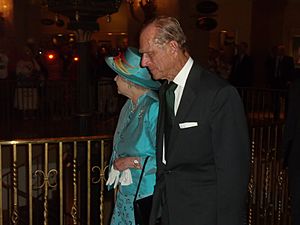
The Royal York Hotel is the favourite place for Queen Elizabeth II and other members of the Canadian Royal Family to stay when they visit Toronto. Queen Elizabeth II first visited the hotel in 1951 with Prince Philip, Duke of Edinburgh. The first members of the Royal Family to visit were King George VI and Queen Elizabeth during their 1939 royal tour of Canada. Other members of the Royal Family who have visited include Prince Andrew, Duke of York; Charles, Prince of Wales; Camilla, Duchess of Cornwall; Prince Harry, Duke of Sussex; and Meghan, Duchess of Sussex.
When the Queen visits, an entire floor is usually reserved for her and her team. She stays in the Royal Suite. The floors above and below her suite are emptied two weeks before she arrives and stay empty until she leaves. The hotel has special items just for the Royal Family, like a private elevator to the Royal Suite. Furniture and other things reserved for the Royal Family, like mattresses and toilets, are kept in storage when they are not being used.
The clock in the main lobby was a gift to the Royal York Hotel from the Royal Family.
See also
 In Spanish: Fairmont Royal York para niños
In Spanish: Fairmont Royal York para niños


